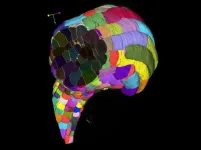(Press-News.org) A high dietary intake of lean and oily fish may slow the progression of disability in people with multiple sclerosis (MS), suggests a comparative population based study, published online in the Journal of Neurology Neurosurgery & Psychiatry.
The anti-inflammatory and neuroprotective properties of the nutrients found in fish may be key, say the researchers, who add that their findings underscore the potential importance of diet in managing the disease.
Emerging evidence indicates that diet may have a role in the development of inflammatory diseases, including MS, explain the researchers.
While previously published research has linked fish consumption with lower levels of disability among those with MS, few studies have looked at whether it might slow or lessen the progression of disability, they point out.
To explore this further, they drew on 2719 newly diagnosed participants (average age 38) in The Epidemiologic Investigation of Multiple Sclerosis (EIMS) study, a Swedish nationwide population based case-control study, all of whom were recruited between April 2005 and June 2015.
On entry to EIMS, all participants provided information on environmental exposures and lifestyle habits, including their consumption of lean and oily fish, which was categorised as: never or seldom; 1 to 3 times a month; and weekly, and scored from 2 to 6, depending on whether they ate lean or oily fish, or both.
Their disease progression, measured using the Expanded Disability Status Scale (EDSS), was tracked for up to 15 years through the Swedish MS Registry.
Confirmed disability worsening was defined as an increase in the EDSS score of at least 1 point from baseline, sustained between two further check-ups, at least 6 months apart.
The highest fish consumption at diagnosis was associated with a 44% lower risk of confirmed disability worsening as well as a 45% lower risk of progressing to EDSS 3 and and a 43% lower risk of progressing to EDSS 4 compared with those who ate none or very little.
And the more lean and oily fish that was consumed, the lower was the risk of confirmed disability worsening and progression to EDSS 3 and 4, trends analysis indicated.
In 2021, 1719 participants completed an online follow-up questionnaire which assessed changes in fish intake over time. Some 412 (24%) had altered their fish consumption: 288 had increased it; 124 had decreased it.
Those who increased their score from 2–3 to a score of 5–6 within 5 years after diagnosis (133) had a 20% lower risk of confirmed disability worsening, compared with those who continued to eat little or no fish (400).
Only 16 participants increased their fish consumption from a baseline score of 2 to a score of 5–6, but they had a 59% lower risk of confirmed disability worsening, compared with those who remained at the lowest level of consumption (101).
The findings held true even when the potentially influential factors of physical activity, weight (BMI), smoking, alcohol intake, and sun exposure were accounted for. They also remained similar when further adjustment was made for vitamin D level.
This is an observational study, and as such, no firm conclusions can be drawn about cause and effect. And further research to validate the findings and investigate the underlying biological mechanisms is required, say the researchers.
But they suggest: “While omega-3 fatty acids, predominantly found in oily fish, may contribute to reduced disability progression, the beneficial effects observed from lean fish consumption suggest that other factors may also play a significant role. One such factor is taurine, an amino acid found in significant amounts in fish and seafood.”
They explain: “Taurine is the most abundant free amino acid in the brain and, although there are endogenous mechanisms for its production, an exogenous supply is necessary to meet physiological needs.”
They add: “Taurine has diverse cellular functions, including cytoprotective actions through antioxidative and anti-inflammatory effects, making it a potential therapeutic agent for neurological disorders.”
And they conclude: “The results underscore the potential role of diet, particularly fish consumption, as a modifiable factor that could complement existing therapeutic strategies for MS.”
END
High dietary fish intake may slow disability progression in MS
Anti-inflammatory, neuroprotective properties of nutrients found in fish may be key. Findings underscore potential importance of diet in managing MS, say researchers
2025-02-26
ELSE PRESS RELEASES FROM THIS DATE:
UK Armed Forces servicewomen face unique set of hurdles for abortion access/care
2025-02-26
UK Armed Forces servicewomen needing an abortion face a unique set of hurdles around access and care, as well as stigma and judgemental attitudes from senior (usually male) colleagues, indicates the first study of its kind, published online in the journal BMJ Sexual & Reproductive Health.
Although based on a relatively low response rate, the findings prompt the researchers to call for more information and policy on abortion provision, both for service personnel and military healthcare professionals.
In the UK around 1 in 3 women ...
Use of strong synthetic opioids during surgery linked to poor composite experience of pain
2025-02-26
The use of powerful synthetic opioids, such as sufentanil and remifentanil, during surgery is linked to a subsequent poor ‘pain experience’---a composite of emotional, cognitive, and physical aspects of pain— suggests research published in the open access journal Regional Anesthesia & Pain Medicine.
The findings highlight the need to reassess intraoperative pain relief strategies to reduce complications after surgery and improve the quality of patient care, say the researchers.
Most patients ...
UK innovation to transform treatment for people with type 2 diabetes worldwide
2025-02-26
Millions of people with type 2 diabetes could receive better treatment thanks to a new, simple low-cost tool, according to groundbreaking research announced today at the Diabetes UK Professional Conference 2025 and published in the Lancet.
Researchers at the University of Exeter, funded by the Medical Research Council, Wellcome and NIHR Exeter Biomedical Research Centre, and supported by Diabetes UK, have developed an innovative way of identifying the most effective glucose-lowering drugs for a person with type 2 diabetes. By predicting which drug will lead to the largest reduction in blood glucose ...
AI model can read ECGs to identify female patients at higher risk of heart disease
2025-02-26
Peer reviewed/ Simulation/modelling /People
A new AI model can flag female patients who are at higher risk of heart disease based on an electrocardiogram (ECG).
The researchers say the algorithm, designed specifically for female patients, could enable doctors to identify high-risk women earlier, enabling better treatment and care. Details are published today in Lancet Digital Health.
An ECG records the electrical activity of the heart and is one of the most common medical tests in the world. In ...
Biological organ ages predict disease risk decades in advance
2025-02-26
Our organs age at different rates, and a blood test determining how much they’ve each aged could predict the risk of conditions like lung cancer and heart disease decades later, finds a new study led by University College London (UCL) researchers.
The findings, published in The Lancet Digital Health, show how accelerated ageing in specific organs can predict not only diseases affecting that organ, but diseases across the rest of the body as well.
Lead author Professor Mika Kivimaki (UCL Faculty of Brain Sciences) said: “Our organs function as an integrated system, but they can age at different rates. ...
New manzanita species discovered, already at risk
2025-02-25
A new species of manzanita — a native California shrub famous for its twisted branches and wildfire resilience — has been discovered on the central coast, but its survival is already threatened by urban development that could destroy much of its fragile population.
The discovery is detailed in a new study published in PhytoKeys, where researchers used genetic analysis to confirm the plant as a distinct species. Named Arctostaphylos nipumu to honor the Nipomo Mesa where it was discovered and its indigenous heritage, the species stands out for its shaggy gray bark — ...
Giant ice bulldozers: How ancient glaciers helped life evolve
2025-02-25
New Curtin University research has revealed how massive ancient glaciers acted like giant bulldozers, reshaping Earth’s surface and paving the way for complex life to flourish.
By chemically analysing crystals in ancient rocks, the researchers discovered that as glaciers carved through the landscape, they scraped deep into the Earth’s crust, releasing key minerals that altered ocean chemistry.
This process had a profound impact on our planet’s composition, creating conditions that allowed ...
Toward high electro-optic performance in III-V semiconductors
2025-02-25
(Santa Barbara, Calif.) — From integrated photonics to quantum information science, the ability to control light with electric fields — a phenomenon known as the electro-optic effect — supports vital applications such as light modulation and frequency transduction. These components rely on nonlinear optical materials, in which light waves can be manipulated by applying electric fields.
Conventional nonlinear optical materials such as lithium niobate have large electro-optic response but are ...
In mouse embryos, sister cells commit suicide in unison
2025-02-25
UdeM reproductive biologist Greg FitzHarris and his team show for the first time that sister cells can communicate with each other through a bridge that allows them to die in a coordinated way.
Sister cells are a pair of cells that share the same mother cell. In a new study published in Developmental Cell, researchers led by Université de Montréal (UdeM) professor Greg FitzHarris show how the early mouse embryo gets rid of the defective or unneeded cells in pairs.
“Such a mechanism could serve to ensure the elimination of cells with a ...
Automatic cell analysis with the help of artificial intelligence
2025-02-25
Identifying and delineating cell structures in microscopy images is crucial for understanding the complex processes of life. This task is called “segmentation” and it enables a range of applications, such as analysing the reaction of cells to drug treatments, or comparing cell structures in different genotypes. It was already possible to carry out automatic segmentation of those biological structures but the dedicated methods only worked in specific conditions and adapting them to new conditions was costly. An international ...
LAST 30 PRESS RELEASES:
New study shows how the spleen helps the immune system accept a transplant
New Mayo Clinic study advances personalized prostate cancer education with an EHR-integrated AI agent
Researchers identify novel therapeutic target to improve recovery after nerve injury
Microbes in breast milk help populate infant gut microbiomes
Reprogramming immunity to rewrite the story of Type 1 diabetes
New tool narrows the search for ideal material structures
Artificial saliva containing sugarcane protein helps protect the teeth of patients with head and neck cancer
Understanding the role of linear ubiquitination in T-tubule biogenesis
Researchers identify urban atmosphere as primary reservoir of microplastics
World’s oldest arrow poison – 60,000-year-old traces reveal early advanced hunting techniques
Bristol scientists discover early sponges were soft
New study uncovers how rice viruses manipulate plant defenses to protect insect vectors
NSF–DOE Vera C. Rubin Observatory spots record-breaking asteroid in pre-survey observations
Ribosomal engineering creates “super-probiotic” bacteria
This self-powered eye tracker harnesses energy from blinking and is as comfortable as everyday glasses
Adverse prenatal exposures linked to higher rates of mental health issues, brain changes in adolescents
Restoring mitochondria shows promise for treating chronic nerve pain
Nature study identifies a molecular switch that controls transitions between single-celled and multicellular forms
USU chemists' CRISPR discovery could lead to single diagnostic test for COVID, flu, RSV
Early hominins from Morocco reveal an African lineage near the root of Homo sapiens
Small chimps, big risks: What chimps show us about our own behavior
We finally know how the most common types of planets are created
Thirty-year risk of cardiovascular disease among healthy women according to clinical thresholds of lipoprotein(a)
Yoga for opioid withdrawal and autonomic regulation
Gene therapy ‘switch’ may offer non-addictive pain relief
Study shows your genes determine how fast your DNA mutates with age
Common brain parasite can infect your immune cells. Here's why that's probably OK
International experts connect infections and aging through cellular senescence
An AI–DFT integrated framework accelerates materials discovery and design
Twist to reshape, shift to transform: Bilayer structure enables multifunctional imaging
[Press-News.org] High dietary fish intake may slow disability progression in MSAnti-inflammatory, neuroprotective properties of nutrients found in fish may be key. Findings underscore potential importance of diet in managing MS, say researchers



